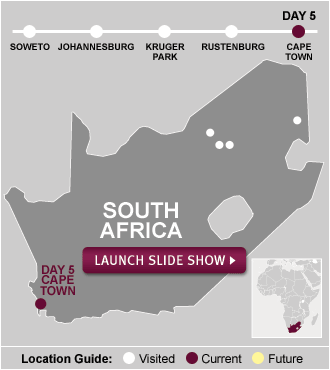World Cup Travels in Post-Apartheid South Africa
It's hard to imagine that something so tangible, so visible in the distance, could have been unknown to someone growing up so near. But there was censorship, and only one TV station, and that's the way apartheid worked: It kept people blind.
There was a soccer league on Robben Island during Nelson Mandela's tenure, Chuck Korr recounts in the book More Than Just a Game. Prisoners constructed goals made from planks of wood and fishing nets washed up on the shores of the island, and an inmate who had been a cobbler cut and molded studs into the soles of sandals the prisoners had fashioned out of car tires.
I call up several former Robben Island inmates who decades ago organized the soccer league and ask them what they think of South Africa's hosting the World Cup.
"I see whites, blacks, they all fly the South African flag for the first time," says Sedick Isaacs, now 70 and a retired professor. "This can change people."
"It's a terrible waste of resources," says Marcus Solomon, also now 70, the founder of a children's organization, who says the stadium construction money could better have been spent on housing for shack-dwellers and the homeless. But of course he is watching the games. "Your soul is dead if you're not interested in sport."
The Cape of Good Hope is the tip of the continent, the meeting of the warm, green-tinged Indian Ocean and the cold, gray-blue Atlantic—and if it isn't the end of the world, it feels like it. The rough rocks and red earth drop down to form a raggedy edge of land, with wind gusting so hard that it's difficult to move against it. This was the first place Europeans landed in South Africa when they came to settle here, when the Dutch East India Company founded the colony of Cape Town as a supply station for ships sailing to India and the Far East. This bit of the world is incredibly beautiful: When we climb to the top of Table Mountain, we are higher than the clouds, and we watch them drift in, first in spiky waves below us, then toward us, encompassing us in tufts of mist.
It's easy to see that this country is one of those places whose incredible physical loveliness coexists with tortured human relations. Of course, I have just skimmed the surface here. But part of what has been most interesting about this trip is seeing the ways South Africa mirrors our own country. Every time I sit down to write about its excesses, I realize they are our own. We, too, are obsessed by race. We, too, have a history where European colonists came, moved to inhospitable hinterlands, developed myths around their hardships, deepened a sense of religious mission, seized land, and moved the native people of the place onto some kind of reserve. In the American case, most of the indigenous people were killed, and now our national mythologizing has mostly moved on. Traveling South Africa, I saw many different ways apartheid played out, and some of them feel somehow familiar, echoes of possible American fates.
But something about this trip has been uncomplicated, too. South Africa is a country whose people love soccer, and they are enjoying a global tournament on their own soil. The soccer love in this country is everywhere: School holidays were extended for the World Cup, work slowed down, and roads closed. This tournament spawned its own arts: clay pots and beaded change purses that say FIFA 2010 (in absolute violation of stringent copyright rules), life-size and key-chain soccer players made of beads, paintings of elephants and zebras kicking soccer balls. Some whites we encountered said they had previously thought of soccer as a game only for blacks, but for the first time they were obsessively following the fate of Bafana Bafana. And, in almost every place we pass through, kids were playing the game—even if the goal posts were piles of rocks in the middle of a dirt street. In a deserted restaurant in a small town where we had a late dinner one night, the waiters started kicking a soccer ball around with a patron inside among the tables—until a few wine glasses were smashed—but the manager just came out and shook his head without reprimand.
I've become used to this routine: Present the gold-embossed FIFA ticket to the collector, share a huge smile, enter a stadium filled with fans in national blocs: the two teams playing, plus South Africans.
Our last game is Spain vs. Portugal in the round of 16.
"No. 8 and No. 6 are kind of like a metronome—they keep the rhythm, they pass the ball back and forth," says my boyfriend, Marcel, of the Spanish team.
Sure enough, I watch fast, even passing: tick, tick, tick.
Over three weeks traveling watching soccer in South Africa, I didn't quite develop a passion for the game, but I did come to appreciate it. I like the way it's pared down—a person and a ball. No other equipment. No armor, no accessories. Just skill, instinct, wiliness, speed. It's a great equalizer and a beautiful thing to watch. No one ever really has the ball—the players can't hold it in their hands—the best any player can do is touch and guide it with the chest, the head, the foot, and move it on.
